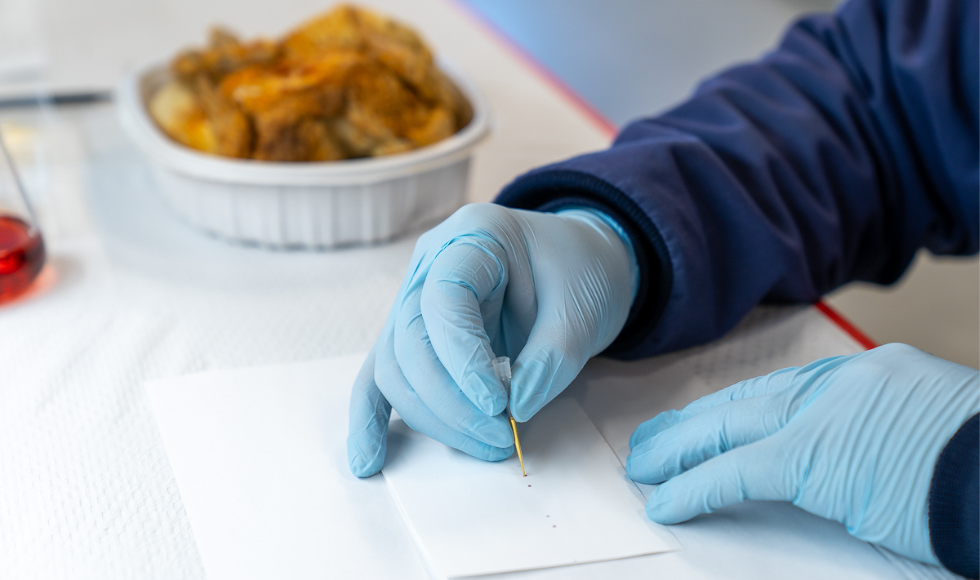Reviewed by Danielle Ellis, B.Sc.Apr 18 2023
McMaster University researchers have devised a quick and low-cost test for Salmonella contamination in chicken and other foods that is simpler to use than a home COVID test.

McMaster researchers have developed an on-the-spot rapid test for salmonella that is easier to conduct than a home COVID test. Image Credit: McMaster University.
The test, described in new research published in the journal Angewandte Chemie, has the potential to improve food safety, lower the cost of processing fresh poultry and other foods, and help to restrict broad recalls to batches that have been explicitly recognized as contaminated.
In comparison to today’s monitoring through lab cultures, which takes at least a full day to produce findings, the researchers demonstrated that the test produces reliable results in an hour or less without the need for attachments or a power source.
Once scaled up and commercially available, the new test might be a huge help to poultry processors, where salmonella is one of the most serious contamination threats.
The test would also be useful in ensuring the safe processing of other foods that are susceptible to salmonella, like eggs, dairy products, and ground beef.
Every year, a single large poultry processor conducts tens of thousands of salmonella lab tests. Reducing or even eliminating the requirement for overnight lab cultures would save costs and make it easier to detect contamination early in the process.
Anyone can use it right in the setting where food is being prepared, processed, or sold. There’s a balance between cost, convenience, and need. If it’s cheap, reliable and easy, why not use it?”
Yingfu Li, Study Co-Author and Professor, Biochemistry and Chemical Biology, McMaster University
Yingfu Li guides McMaster’s Functional Nucleic Acids Research Group.
Salmonella is one of the most common and dangerous forms of food-borne infection, causing 155,000 fatalities globally each year. Protecting the public is a top priority for food manufacturers, retailers, and regulators alike.
The test is made possible by a new synthetic nucleic acid molecule produced at McMaster. The molecule is sandwiched between small particles such as gold for the test.
The test platform lines the interior of a pipette tip and starts working when a liquefied sample of the food being tested is drawn within the tube.
Sometimes when salmonella bacteria are present, they cut through the particles, enabling the molecule to escape.
The presence of salmonella appears as a visible shade of red when the solution is placed onto a paper test strip due to a new type of biosensor developed by the McMaster team. The brighter the color appears, the higher the concentration of salmonella.
Using these tests is easier than using a COVID test, which so many people are already doing. For this to be as effective and useful as possible, it has to be easy to use.”
Carlos Filipe, Study Co-Author and Chair, Department of Chemical Engineering, McMaster University
The new technology was created with the help of the non-profit research group Mitacs and Toyota Tsusho Canada Inc., an indirect subsidiary of Toyota Tsusho Corporation in Japan that hopes to commercialize the breakthrough.
The study is part of a larger effort to establish McMaster and its Global Nexus for Pandemics and Biological Threats as a center for the development of real-time sensors, pathogen-repellent materials, and other food safety technologies.
This is very important to us in the development of our food-testing program. Being able to create a test that is easy to use and which produces a readily visible color within an hour is significant.”
Tohid Didar, Study Co-Author, Associate Professor of Mechanical Engineering, McMaster University
Tohid Didar is the Canada Research Chair in Nano-biomaterials.
Li, Didar, and Filipe authored the paper with postdoctoral research fellow Jiuxing Li, Ph.D. student and Vanier Scholar Shadman Khan, and research associate Jimmy Gu.
Toyota Tsusho Canada Inc. President Grant Town noted that reducing sickness and food waste corresponds with Toyota Tsusho Canada’s principles.
Town notes, “Our goal is to help bring proven research from the lab to the marketplace, where it can benefit society. Reducing the risk of illness while also cutting food waste will benefit everyone, and Toyota Tsusho Canada sees this as a great opportunity.”
Salmonella Solution
Video Credit: McMaster University
Source:
Journal reference:
Li, J., et al. (2023). A Simple Colorimetric Au‐on‐Au Tip Sensor with a New Functional Nucleic Acid Probe for Food‐borne Pathogen Salmonella typhimurium. Angewandte Chemie International Edition. doi.org/10.1002/anie.202300828.